Capstone Project: Development of QHS Operational Plan, QHS
VerifiedAdded on 2023/03/17
|11
|2412
|28
Project
AI Summary
This capstone project focuses on developing an operational plan for the Queenan Health System (QHS) to enhance its services and become a High Reliability Organization (HRO). The assignment begins with an introduction highlighting the challenges faced by healthcare organizations in delivering high-quality services and the importance of continuous improvement. The project recommends two key strategies for improving quality and patient safety: the Institute for Healthcare Improvement (IHI) model for improvement and the lean strategy. It then outlines the KPIs, objectives, and activities associated with these strategies. A significant portion of the project is dedicated to a risk management plan aimed at creating a "just culture" within QHS. The plan addresses leadership support, staff surveys, discussion sessions, and knowledge sharing. The project also analyzes how QHS can ensure compliance with ethical, regulatory, and legal standards, particularly referencing ISO standards. Finally, it recommends a process for continuous monitoring and quality improvement, including the implementation of an electronic health records system (EHRs) and outlines staffing and resource requirements for implementing these improvements.
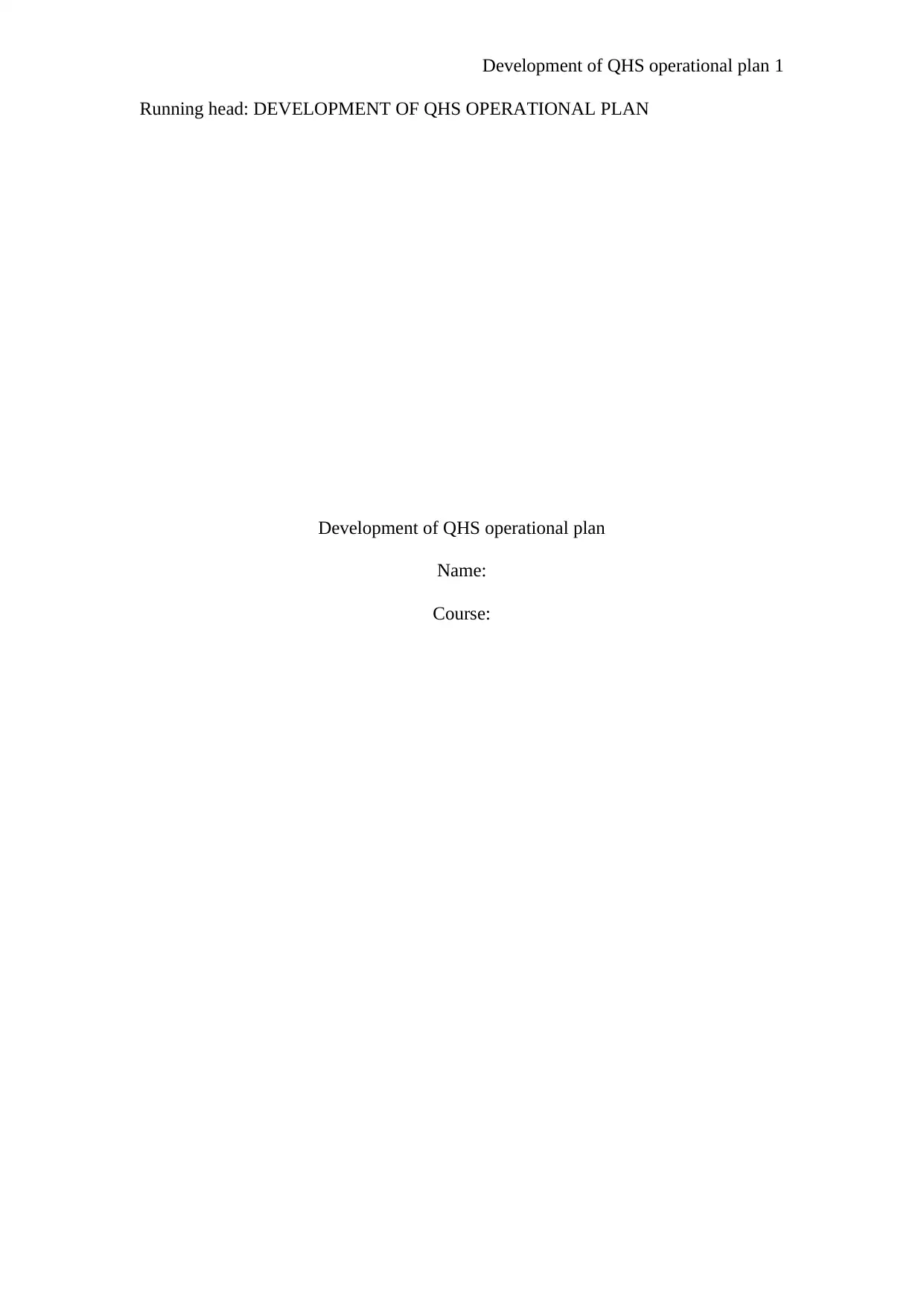
1Development of QHS operational plan
Running head: DEVELOPMENT OF QHS OPERATIONAL PLAN
Development of QHS operational plan
Name:
Course:
Running head: DEVELOPMENT OF QHS OPERATIONAL PLAN
Development of QHS operational plan
Name:
Course:
Paraphrase This Document
Need a fresh take? Get an instant paraphrase of this document with our AI Paraphraser
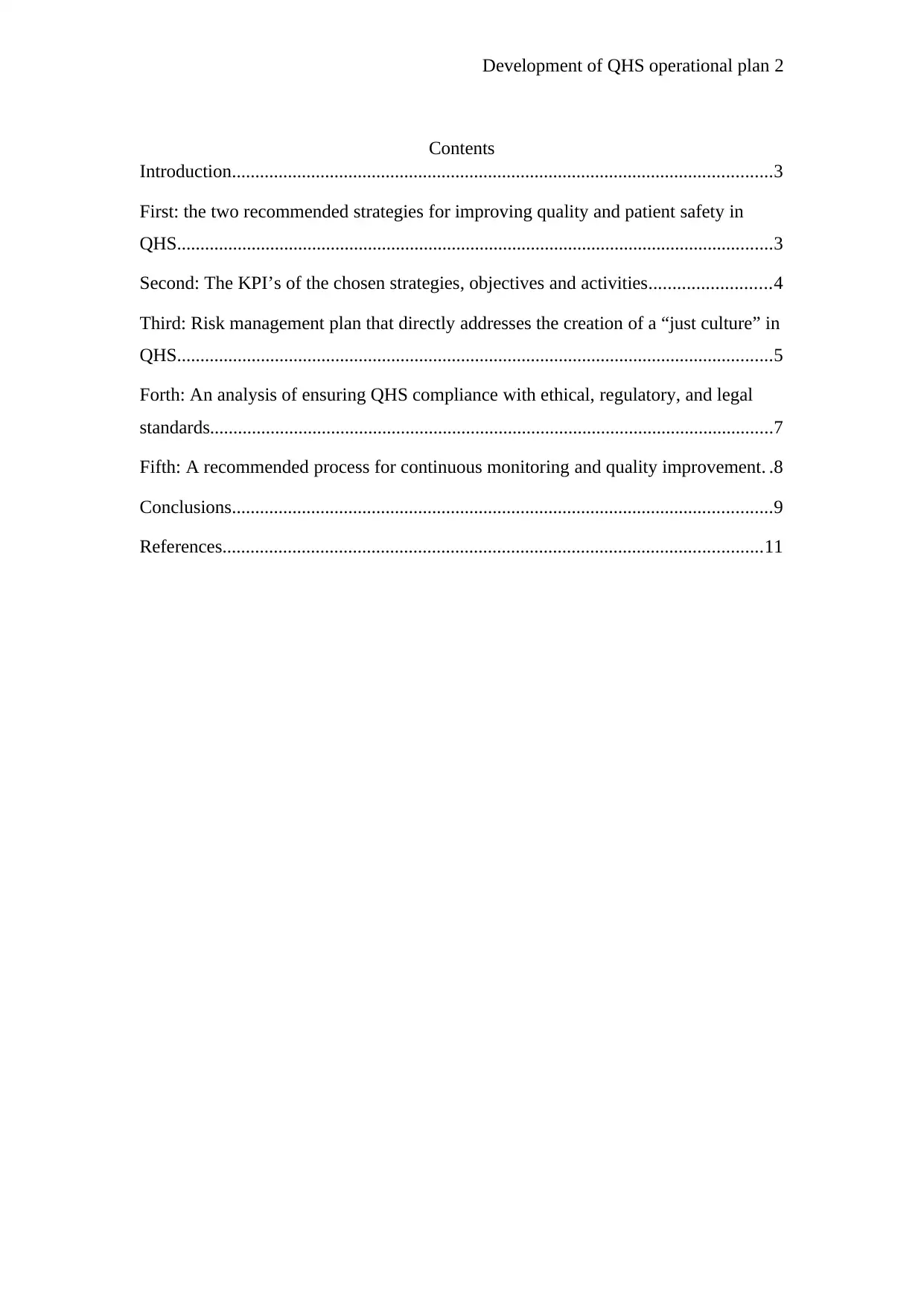
2Development of QHS operational plan
Contents
Introduction....................................................................................................................3
First: the two recommended strategies for improving quality and patient safety in
QHS................................................................................................................................3
Second: The KPI’s of the chosen strategies, objectives and activities..........................4
Third: Risk management plan that directly addresses the creation of a “just culture” in
QHS................................................................................................................................5
Forth: An analysis of ensuring QHS compliance with ethical, regulatory, and legal
standards.........................................................................................................................7
Fifth: A recommended process for continuous monitoring and quality improvement. .8
Conclusions....................................................................................................................9
References....................................................................................................................11
Contents
Introduction....................................................................................................................3
First: the two recommended strategies for improving quality and patient safety in
QHS................................................................................................................................3
Second: The KPI’s of the chosen strategies, objectives and activities..........................4
Third: Risk management plan that directly addresses the creation of a “just culture” in
QHS................................................................................................................................5
Forth: An analysis of ensuring QHS compliance with ethical, regulatory, and legal
standards.........................................................................................................................7
Fifth: A recommended process for continuous monitoring and quality improvement. .8
Conclusions....................................................................................................................9
References....................................................................................................................11
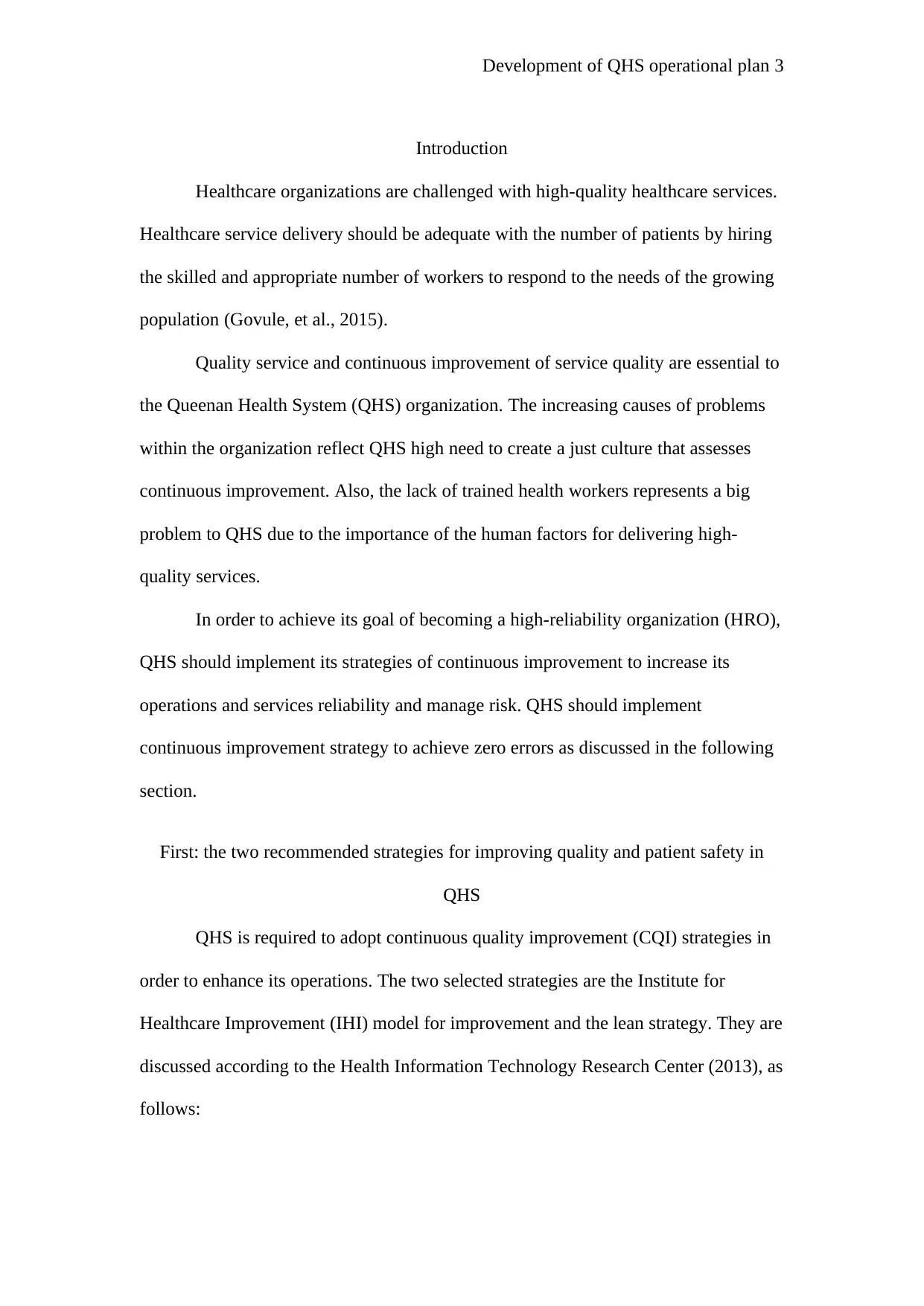
3Development of QHS operational plan
Introduction
Healthcare organizations are challenged with high-quality healthcare services.
Healthcare service delivery should be adequate with the number of patients by hiring
the skilled and appropriate number of workers to respond to the needs of the growing
population (Govule, et al., 2015).
Quality service and continuous improvement of service quality are essential to
the Queenan Health System (QHS) organization. The increasing causes of problems
within the organization reflect QHS high need to create a just culture that assesses
continuous improvement. Also, the lack of trained health workers represents a big
problem to QHS due to the importance of the human factors for delivering high-
quality services.
In order to achieve its goal of becoming a high-reliability organization (HRO),
QHS should implement its strategies of continuous improvement to increase its
operations and services reliability and manage risk. QHS should implement
continuous improvement strategy to achieve zero errors as discussed in the following
section.
First: the two recommended strategies for improving quality and patient safety in
QHS
QHS is required to adopt continuous quality improvement (CQI) strategies in
order to enhance its operations. The two selected strategies are the Institute for
Healthcare Improvement (IHI) model for improvement and the lean strategy. They are
discussed according to the Health Information Technology Research Center (2013), as
follows:
Introduction
Healthcare organizations are challenged with high-quality healthcare services.
Healthcare service delivery should be adequate with the number of patients by hiring
the skilled and appropriate number of workers to respond to the needs of the growing
population (Govule, et al., 2015).
Quality service and continuous improvement of service quality are essential to
the Queenan Health System (QHS) organization. The increasing causes of problems
within the organization reflect QHS high need to create a just culture that assesses
continuous improvement. Also, the lack of trained health workers represents a big
problem to QHS due to the importance of the human factors for delivering high-
quality services.
In order to achieve its goal of becoming a high-reliability organization (HRO),
QHS should implement its strategies of continuous improvement to increase its
operations and services reliability and manage risk. QHS should implement
continuous improvement strategy to achieve zero errors as discussed in the following
section.
First: the two recommended strategies for improving quality and patient safety in
QHS
QHS is required to adopt continuous quality improvement (CQI) strategies in
order to enhance its operations. The two selected strategies are the Institute for
Healthcare Improvement (IHI) model for improvement and the lean strategy. They are
discussed according to the Health Information Technology Research Center (2013), as
follows:
⊘ This is a preview!⊘
Do you want full access?
Subscribe today to unlock all pages.

Trusted by 1+ million students worldwide
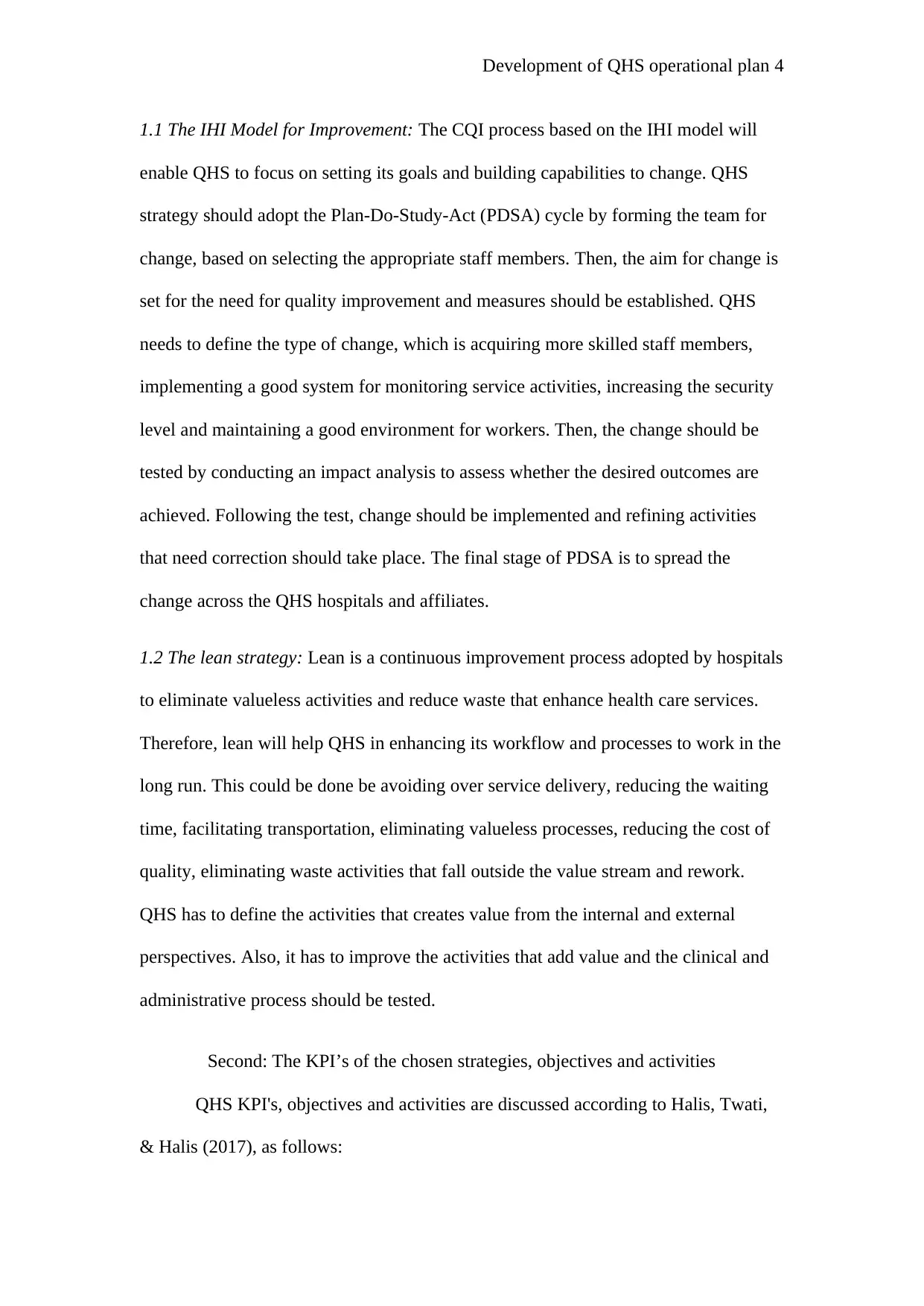
4Development of QHS operational plan
1.1 The IHI Model for Improvement: The CQI process based on the IHI model will
enable QHS to focus on setting its goals and building capabilities to change. QHS
strategy should adopt the Plan-Do-Study-Act (PDSA) cycle by forming the team for
change, based on selecting the appropriate staff members. Then, the aim for change is
set for the need for quality improvement and measures should be established. QHS
needs to define the type of change, which is acquiring more skilled staff members,
implementing a good system for monitoring service activities, increasing the security
level and maintaining a good environment for workers. Then, the change should be
tested by conducting an impact analysis to assess whether the desired outcomes are
achieved. Following the test, change should be implemented and refining activities
that need correction should take place. The final stage of PDSA is to spread the
change across the QHS hospitals and affiliates.
1.2 The lean strategy: Lean is a continuous improvement process adopted by hospitals
to eliminate valueless activities and reduce waste that enhance health care services.
Therefore, lean will help QHS in enhancing its workflow and processes to work in the
long run. This could be done be avoiding over service delivery, reducing the waiting
time, facilitating transportation, eliminating valueless processes, reducing the cost of
quality, eliminating waste activities that fall outside the value stream and rework.
QHS has to define the activities that creates value from the internal and external
perspectives. Also, it has to improve the activities that add value and the clinical and
administrative process should be tested.
Second: The KPI’s of the chosen strategies, objectives and activities
QHS KPI's, objectives and activities are discussed according to Halis, Twati,
& Halis (2017), as follows:
1.1 The IHI Model for Improvement: The CQI process based on the IHI model will
enable QHS to focus on setting its goals and building capabilities to change. QHS
strategy should adopt the Plan-Do-Study-Act (PDSA) cycle by forming the team for
change, based on selecting the appropriate staff members. Then, the aim for change is
set for the need for quality improvement and measures should be established. QHS
needs to define the type of change, which is acquiring more skilled staff members,
implementing a good system for monitoring service activities, increasing the security
level and maintaining a good environment for workers. Then, the change should be
tested by conducting an impact analysis to assess whether the desired outcomes are
achieved. Following the test, change should be implemented and refining activities
that need correction should take place. The final stage of PDSA is to spread the
change across the QHS hospitals and affiliates.
1.2 The lean strategy: Lean is a continuous improvement process adopted by hospitals
to eliminate valueless activities and reduce waste that enhance health care services.
Therefore, lean will help QHS in enhancing its workflow and processes to work in the
long run. This could be done be avoiding over service delivery, reducing the waiting
time, facilitating transportation, eliminating valueless processes, reducing the cost of
quality, eliminating waste activities that fall outside the value stream and rework.
QHS has to define the activities that creates value from the internal and external
perspectives. Also, it has to improve the activities that add value and the clinical and
administrative process should be tested.
Second: The KPI’s of the chosen strategies, objectives and activities
QHS KPI's, objectives and activities are discussed according to Halis, Twati,
& Halis (2017), as follows:
Paraphrase This Document
Need a fresh take? Get an instant paraphrase of this document with our AI Paraphraser
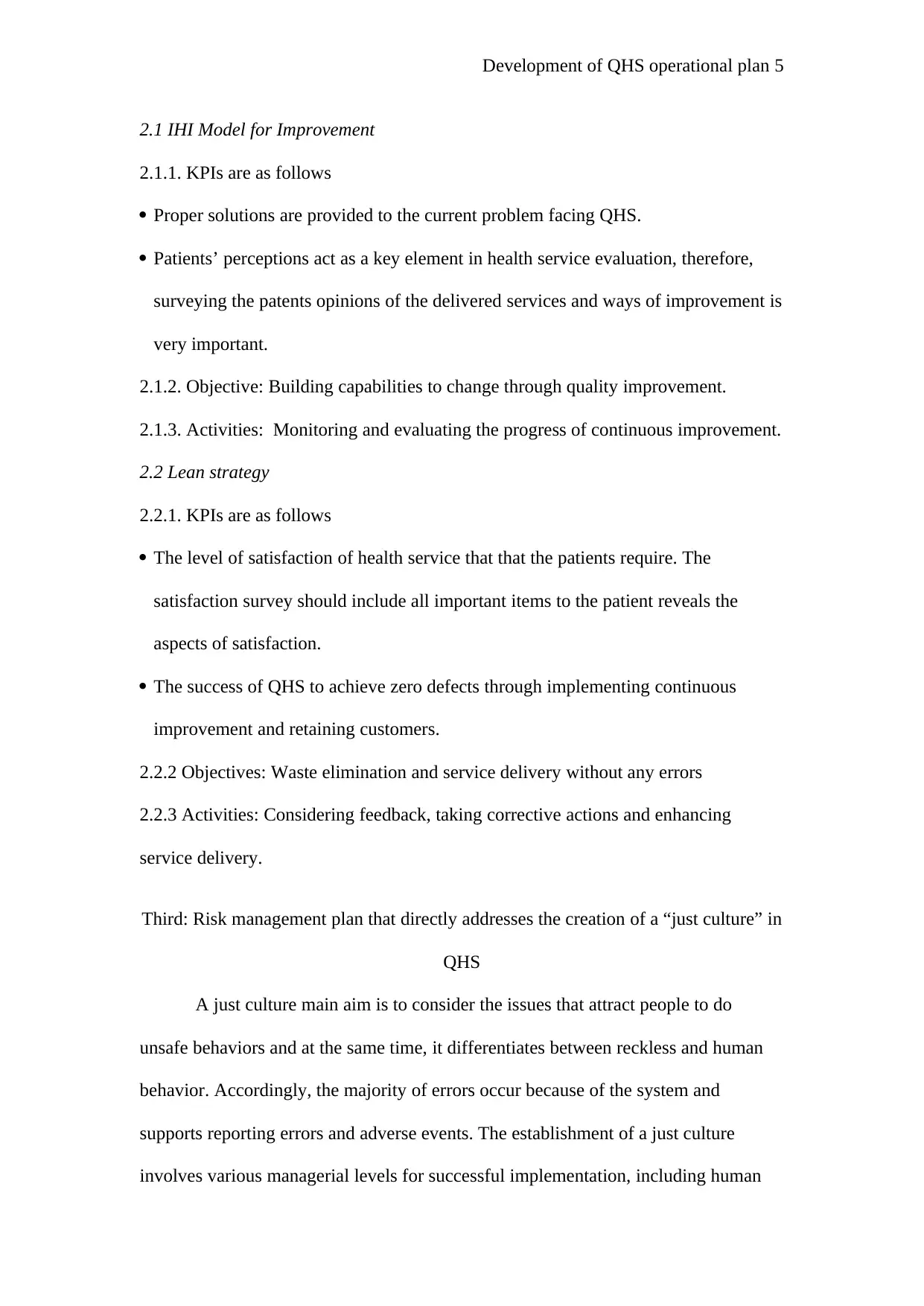
5Development of QHS operational plan
2.1 IHI Model for Improvement
2.1.1. KPIs are as follows
Proper solutions are provided to the current problem facing QHS.
Patients’ perceptions act as a key element in health service evaluation, therefore,
surveying the patents opinions of the delivered services and ways of improvement is
very important.
2.1.2. Objective: Building capabilities to change through quality improvement.
2.1.3. Activities: Monitoring and evaluating the progress of continuous improvement.
2.2 Lean strategy
2.2.1. KPIs are as follows
The level of satisfaction of health service that that the patients require. The
satisfaction survey should include all important items to the patient reveals the
aspects of satisfaction.
The success of QHS to achieve zero defects through implementing continuous
improvement and retaining customers.
2.2.2 Objectives: Waste elimination and service delivery without any errors
2.2.3 Activities: Considering feedback, taking corrective actions and enhancing
service delivery.
Third: Risk management plan that directly addresses the creation of a “just culture” in
QHS
A just culture main aim is to consider the issues that attract people to do
unsafe behaviors and at the same time, it differentiates between reckless and human
behavior. Accordingly, the majority of errors occur because of the system and
supports reporting errors and adverse events. The establishment of a just culture
involves various managerial levels for successful implementation, including human
2.1 IHI Model for Improvement
2.1.1. KPIs are as follows
Proper solutions are provided to the current problem facing QHS.
Patients’ perceptions act as a key element in health service evaluation, therefore,
surveying the patents opinions of the delivered services and ways of improvement is
very important.
2.1.2. Objective: Building capabilities to change through quality improvement.
2.1.3. Activities: Monitoring and evaluating the progress of continuous improvement.
2.2 Lean strategy
2.2.1. KPIs are as follows
The level of satisfaction of health service that that the patients require. The
satisfaction survey should include all important items to the patient reveals the
aspects of satisfaction.
The success of QHS to achieve zero defects through implementing continuous
improvement and retaining customers.
2.2.2 Objectives: Waste elimination and service delivery without any errors
2.2.3 Activities: Considering feedback, taking corrective actions and enhancing
service delivery.
Third: Risk management plan that directly addresses the creation of a “just culture” in
QHS
A just culture main aim is to consider the issues that attract people to do
unsafe behaviors and at the same time, it differentiates between reckless and human
behavior. Accordingly, the majority of errors occur because of the system and
supports reporting errors and adverse events. The establishment of a just culture
involves various managerial levels for successful implementation, including human
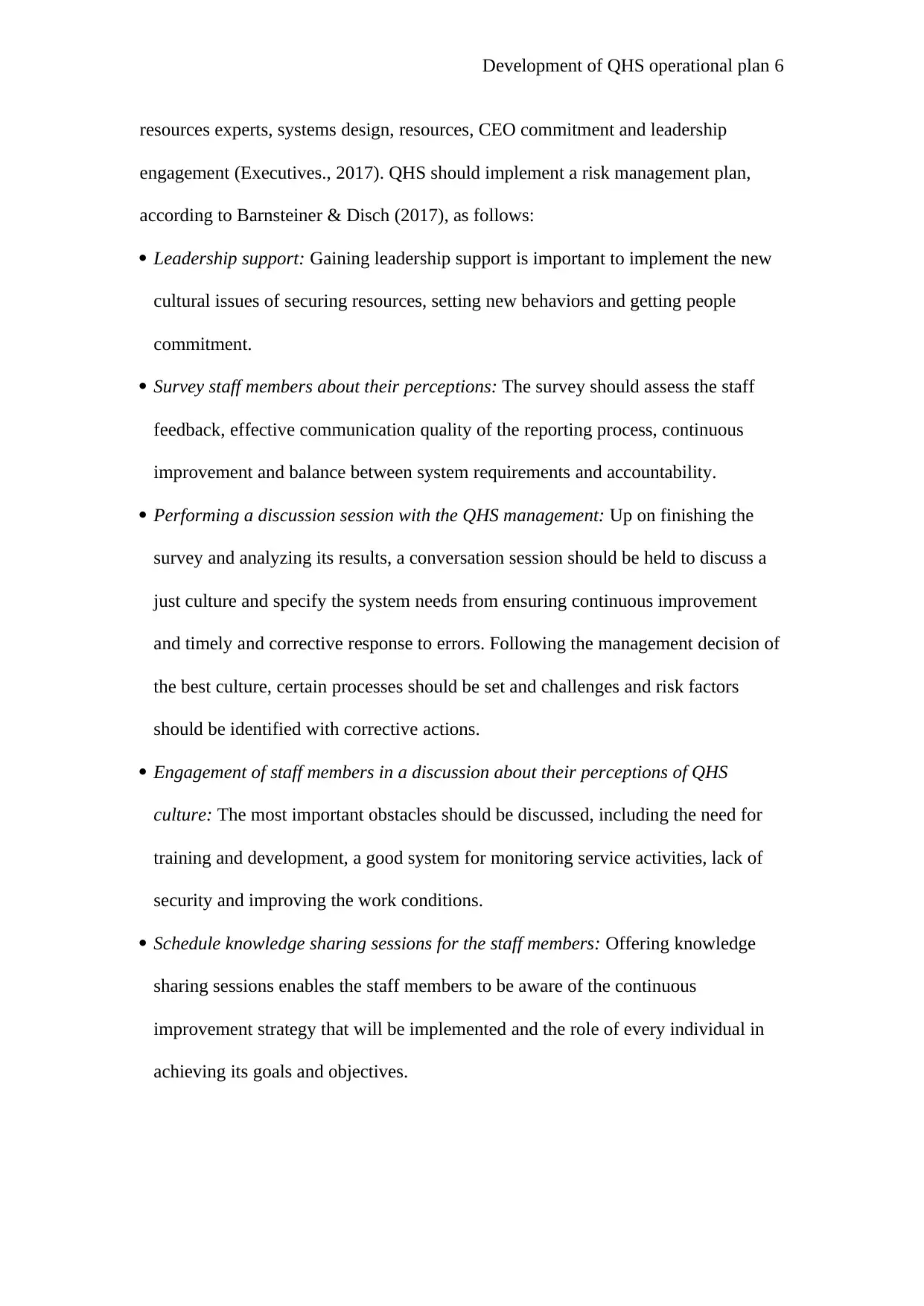
6Development of QHS operational plan
resources experts, systems design, resources, CEO commitment and leadership
engagement (Executives., 2017). QHS should implement a risk management plan,
according to Barnsteiner & Disch (2017), as follows:
Leadership support: Gaining leadership support is important to implement the new
cultural issues of securing resources, setting new behaviors and getting people
commitment.
Survey staff members about their perceptions: The survey should assess the staff
feedback, effective communication quality of the reporting process, continuous
improvement and balance between system requirements and accountability.
Performing a discussion session with the QHS management: Up on finishing the
survey and analyzing its results, a conversation session should be held to discuss a
just culture and specify the system needs from ensuring continuous improvement
and timely and corrective response to errors. Following the management decision of
the best culture, certain processes should be set and challenges and risk factors
should be identified with corrective actions.
Engagement of staff members in a discussion about their perceptions of QHS
culture: The most important obstacles should be discussed, including the need for
training and development, a good system for monitoring service activities, lack of
security and improving the work conditions.
Schedule knowledge sharing sessions for the staff members: Offering knowledge
sharing sessions enables the staff members to be aware of the continuous
improvement strategy that will be implemented and the role of every individual in
achieving its goals and objectives.
resources experts, systems design, resources, CEO commitment and leadership
engagement (Executives., 2017). QHS should implement a risk management plan,
according to Barnsteiner & Disch (2017), as follows:
Leadership support: Gaining leadership support is important to implement the new
cultural issues of securing resources, setting new behaviors and getting people
commitment.
Survey staff members about their perceptions: The survey should assess the staff
feedback, effective communication quality of the reporting process, continuous
improvement and balance between system requirements and accountability.
Performing a discussion session with the QHS management: Up on finishing the
survey and analyzing its results, a conversation session should be held to discuss a
just culture and specify the system needs from ensuring continuous improvement
and timely and corrective response to errors. Following the management decision of
the best culture, certain processes should be set and challenges and risk factors
should be identified with corrective actions.
Engagement of staff members in a discussion about their perceptions of QHS
culture: The most important obstacles should be discussed, including the need for
training and development, a good system for monitoring service activities, lack of
security and improving the work conditions.
Schedule knowledge sharing sessions for the staff members: Offering knowledge
sharing sessions enables the staff members to be aware of the continuous
improvement strategy that will be implemented and the role of every individual in
achieving its goals and objectives.
⊘ This is a preview!⊘
Do you want full access?
Subscribe today to unlock all pages.

Trusted by 1+ million students worldwide
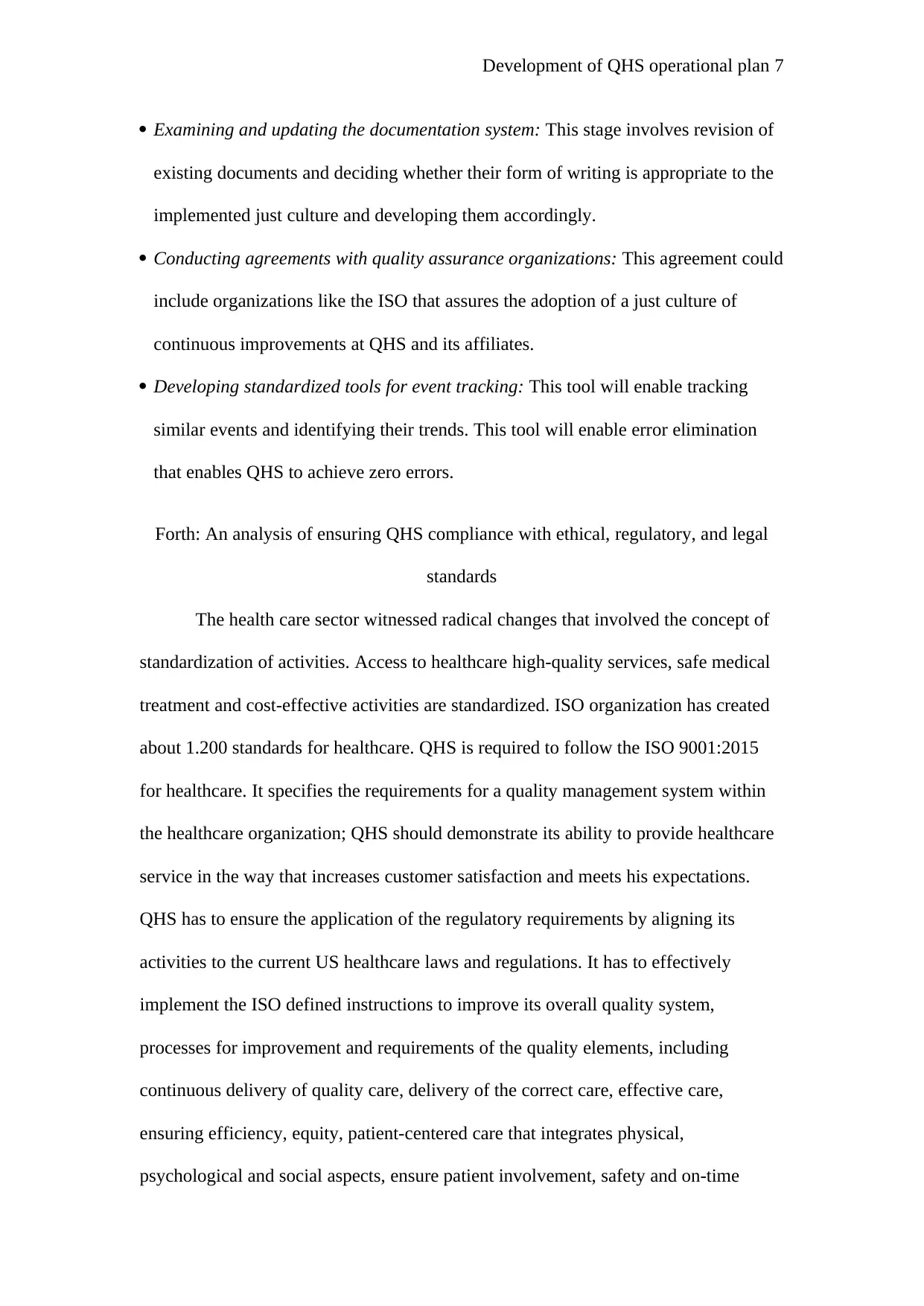
7Development of QHS operational plan
Examining and updating the documentation system: This stage involves revision of
existing documents and deciding whether their form of writing is appropriate to the
implemented just culture and developing them accordingly.
Conducting agreements with quality assurance organizations: This agreement could
include organizations like the ISO that assures the adoption of a just culture of
continuous improvements at QHS and its affiliates.
Developing standardized tools for event tracking: This tool will enable tracking
similar events and identifying their trends. This tool will enable error elimination
that enables QHS to achieve zero errors.
Forth: An analysis of ensuring QHS compliance with ethical, regulatory, and legal
standards
The health care sector witnessed radical changes that involved the concept of
standardization of activities. Access to healthcare high-quality services, safe medical
treatment and cost-effective activities are standardized. ISO organization has created
about 1.200 standards for healthcare. QHS is required to follow the ISO 9001:2015
for healthcare. It specifies the requirements for a quality management system within
the healthcare organization; QHS should demonstrate its ability to provide healthcare
service in the way that increases customer satisfaction and meets his expectations.
QHS has to ensure the application of the regulatory requirements by aligning its
activities to the current US healthcare laws and regulations. It has to effectively
implement the ISO defined instructions to improve its overall quality system,
processes for improvement and requirements of the quality elements, including
continuous delivery of quality care, delivery of the correct care, effective care,
ensuring efficiency, equity, patient-centered care that integrates physical,
psychological and social aspects, ensure patient involvement, safety and on-time
Examining and updating the documentation system: This stage involves revision of
existing documents and deciding whether their form of writing is appropriate to the
implemented just culture and developing them accordingly.
Conducting agreements with quality assurance organizations: This agreement could
include organizations like the ISO that assures the adoption of a just culture of
continuous improvements at QHS and its affiliates.
Developing standardized tools for event tracking: This tool will enable tracking
similar events and identifying their trends. This tool will enable error elimination
that enables QHS to achieve zero errors.
Forth: An analysis of ensuring QHS compliance with ethical, regulatory, and legal
standards
The health care sector witnessed radical changes that involved the concept of
standardization of activities. Access to healthcare high-quality services, safe medical
treatment and cost-effective activities are standardized. ISO organization has created
about 1.200 standards for healthcare. QHS is required to follow the ISO 9001:2015
for healthcare. It specifies the requirements for a quality management system within
the healthcare organization; QHS should demonstrate its ability to provide healthcare
service in the way that increases customer satisfaction and meets his expectations.
QHS has to ensure the application of the regulatory requirements by aligning its
activities to the current US healthcare laws and regulations. It has to effectively
implement the ISO defined instructions to improve its overall quality system,
processes for improvement and requirements of the quality elements, including
continuous delivery of quality care, delivery of the correct care, effective care,
ensuring efficiency, equity, patient-centered care that integrates physical,
psychological and social aspects, ensure patient involvement, safety and on-time
Paraphrase This Document
Need a fresh take? Get an instant paraphrase of this document with our AI Paraphraser

8Development of QHS operational plan
accessibility. Also, adopting SRPS EN ISO 15189:2014 of medical laboratories
requirements for quality and competence that defines the quality of medical
laboratories. In addition, adopting SRPS EN ISO 13485:2017 of medical devices
quality management systems that define the aspects of regulatory purposes (Tosic,
Ruso, & Filipovic, 2018).
Fifth: A recommended process for continuous monitoring and quality improvement
CQI represents an effective process for quality management in healthcare that
encourages the staff members to ask specific questions continuously, how are we
doing? could this activity be done in a better way?. QHS should collect clinical and
administrative data to develop an electronic health records system (EHRs). This
system is capable of capturing data effectively and efficiently and transforming the
patient data into electronic records rather than the paper system. In this case, the
patient required drugs will not be forgotten, also, the surgery timing will be well
defined according to the right diagnoses due to accurate data system that facilitates
the service delivery with the highest quality. QHS adoption of the CQI strategies will
be used as an input to design an effective HER that achieves the maximum
improvement of patient safety and service quality. Then, the staff members should ask
more specific questions, like how can we do it faster? and how can we do it more
efficiently? QHS is required to increase the staff member of the importance and use of
EHRs, which could be done through training and development that clearly states the
current situation and the future desired situation after the system implementation.
Accordingly, the staff members will be able to judge whether they achieved the
desired outcomes of failed to do. Also, they should be allowed to give their feedback
about the system performance to correct the CQI strategy implementation based on
accessibility. Also, adopting SRPS EN ISO 15189:2014 of medical laboratories
requirements for quality and competence that defines the quality of medical
laboratories. In addition, adopting SRPS EN ISO 13485:2017 of medical devices
quality management systems that define the aspects of regulatory purposes (Tosic,
Ruso, & Filipovic, 2018).
Fifth: A recommended process for continuous monitoring and quality improvement
CQI represents an effective process for quality management in healthcare that
encourages the staff members to ask specific questions continuously, how are we
doing? could this activity be done in a better way?. QHS should collect clinical and
administrative data to develop an electronic health records system (EHRs). This
system is capable of capturing data effectively and efficiently and transforming the
patient data into electronic records rather than the paper system. In this case, the
patient required drugs will not be forgotten, also, the surgery timing will be well
defined according to the right diagnoses due to accurate data system that facilitates
the service delivery with the highest quality. QHS adoption of the CQI strategies will
be used as an input to design an effective HER that achieves the maximum
improvement of patient safety and service quality. Then, the staff members should ask
more specific questions, like how can we do it faster? and how can we do it more
efficiently? QHS is required to increase the staff member of the importance and use of
EHRs, which could be done through training and development that clearly states the
current situation and the future desired situation after the system implementation.
Accordingly, the staff members will be able to judge whether they achieved the
desired outcomes of failed to do. Also, they should be allowed to give their feedback
about the system performance to correct the CQI strategy implementation based on
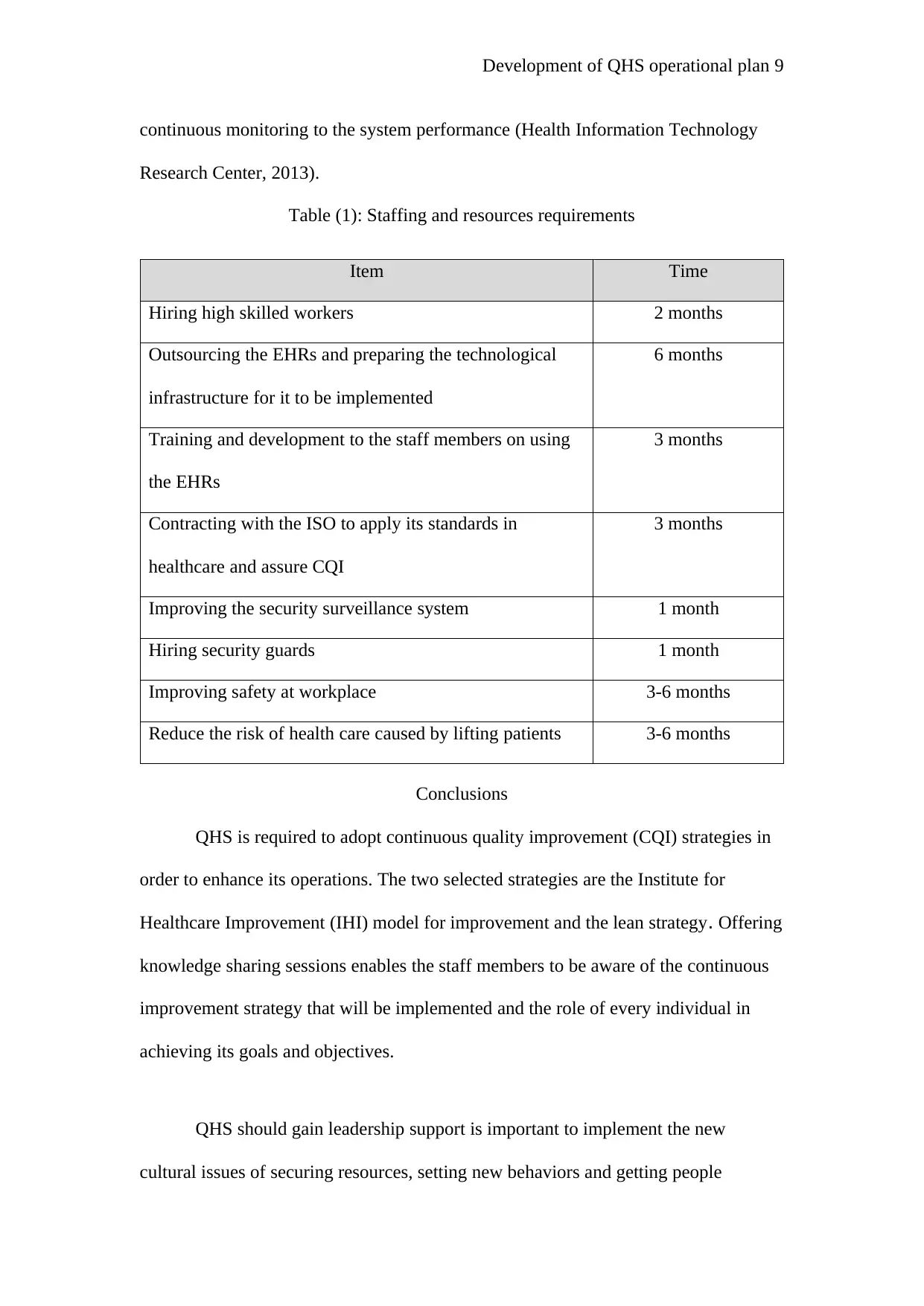
9Development of QHS operational plan
continuous monitoring to the system performance (Health Information Technology
Research Center, 2013).
Table (1): Staffing and resources requirements
Item Time
Hiring high skilled workers 2 months
Outsourcing the EHRs and preparing the technological
infrastructure for it to be implemented
6 months
Training and development to the staff members on using
the EHRs
3 months
Contracting with the ISO to apply its standards in
healthcare and assure CQI
3 months
Improving the security surveillance system 1 month
Hiring security guards 1 month
Improving safety at workplace 3-6 months
Reduce the risk of health care caused by lifting patients 3-6 months
Conclusions
QHS is required to adopt continuous quality improvement (CQI) strategies in
order to enhance its operations. The two selected strategies are the Institute for
Healthcare Improvement (IHI) model for improvement and the lean strategy. Offering
knowledge sharing sessions enables the staff members to be aware of the continuous
improvement strategy that will be implemented and the role of every individual in
achieving its goals and objectives.
QHS should gain leadership support is important to implement the new
cultural issues of securing resources, setting new behaviors and getting people
continuous monitoring to the system performance (Health Information Technology
Research Center, 2013).
Table (1): Staffing and resources requirements
Item Time
Hiring high skilled workers 2 months
Outsourcing the EHRs and preparing the technological
infrastructure for it to be implemented
6 months
Training and development to the staff members on using
the EHRs
3 months
Contracting with the ISO to apply its standards in
healthcare and assure CQI
3 months
Improving the security surveillance system 1 month
Hiring security guards 1 month
Improving safety at workplace 3-6 months
Reduce the risk of health care caused by lifting patients 3-6 months
Conclusions
QHS is required to adopt continuous quality improvement (CQI) strategies in
order to enhance its operations. The two selected strategies are the Institute for
Healthcare Improvement (IHI) model for improvement and the lean strategy. Offering
knowledge sharing sessions enables the staff members to be aware of the continuous
improvement strategy that will be implemented and the role of every individual in
achieving its goals and objectives.
QHS should gain leadership support is important to implement the new
cultural issues of securing resources, setting new behaviors and getting people
⊘ This is a preview!⊘
Do you want full access?
Subscribe today to unlock all pages.

Trusted by 1+ million students worldwide
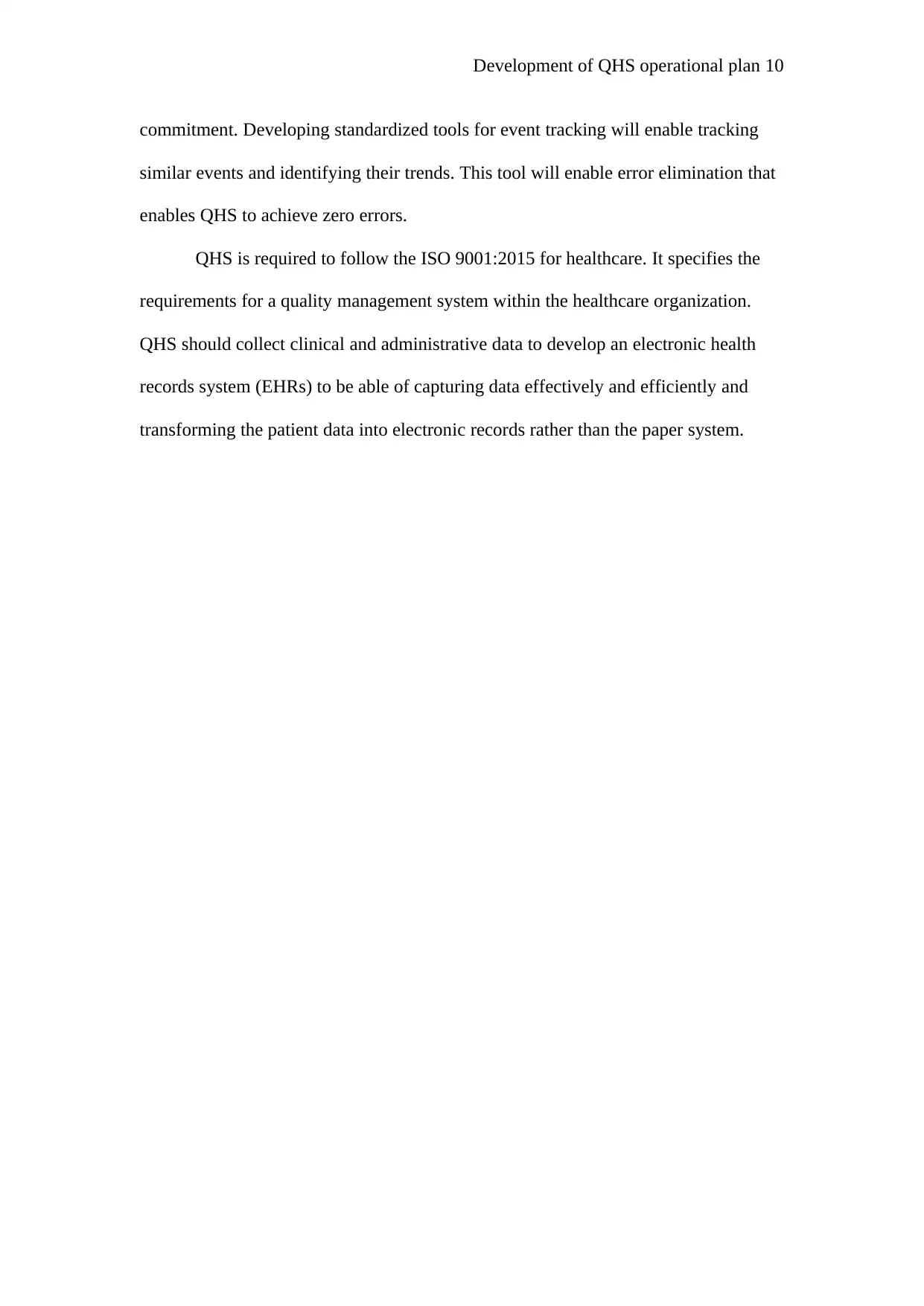
10Development of QHS operational plan
commitment. Developing standardized tools for event tracking will enable tracking
similar events and identifying their trends. This tool will enable error elimination that
enables QHS to achieve zero errors.
QHS is required to follow the ISO 9001:2015 for healthcare. It specifies the
requirements for a quality management system within the healthcare organization.
QHS should collect clinical and administrative data to develop an electronic health
records system (EHRs) to be able of capturing data effectively and efficiently and
transforming the patient data into electronic records rather than the paper system.
commitment. Developing standardized tools for event tracking will enable tracking
similar events and identifying their trends. This tool will enable error elimination that
enables QHS to achieve zero errors.
QHS is required to follow the ISO 9001:2015 for healthcare. It specifies the
requirements for a quality management system within the healthcare organization.
QHS should collect clinical and administrative data to develop an electronic health
records system (EHRs) to be able of capturing data effectively and efficiently and
transforming the patient data into electronic records rather than the paper system.
Paraphrase This Document
Need a fresh take? Get an instant paraphrase of this document with our AI Paraphraser
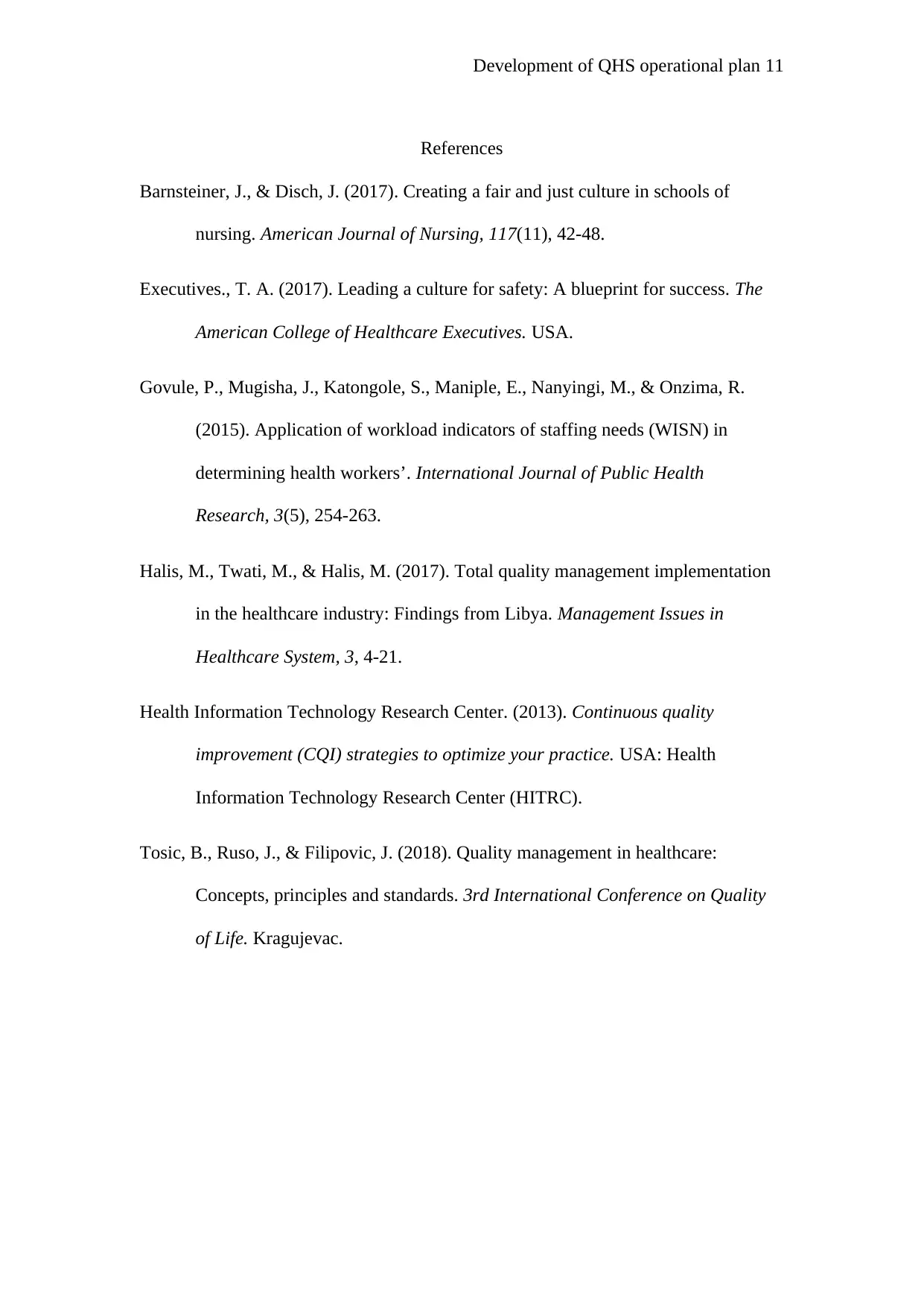
11Development of QHS operational plan
References
Barnsteiner, J., & Disch, J. (2017). Creating a fair and just culture in schools of
nursing. American Journal of Nursing, 117(11), 42-48.
Executives., T. A. (2017). Leading a culture for safety: A blueprint for success. The
American College of Healthcare Executives. USA.
Govule, P., Mugisha, J., Katongole, S., Maniple, E., Nanyingi, M., & Onzima, R.
(2015). Application of workload indicators of staffing needs (WISN) in
determining health workers’. International Journal of Public Health
Research, 3(5), 254-263.
Halis, M., Twati, M., & Halis, M. (2017). Total quality management implementation
in the healthcare industry: Findings from Libya. Management Issues in
Healthcare System, 3, 4-21.
Health Information Technology Research Center. (2013). Continuous quality
improvement (CQI) strategies to optimize your practice. USA: Health
Information Technology Research Center (HITRC).
Tosic, B., Ruso, J., & Filipovic, J. (2018). Quality management in healthcare:
Concepts, principles and standards. 3rd International Conference on Quality
of Life. Kragujevac.
References
Barnsteiner, J., & Disch, J. (2017). Creating a fair and just culture in schools of
nursing. American Journal of Nursing, 117(11), 42-48.
Executives., T. A. (2017). Leading a culture for safety: A blueprint for success. The
American College of Healthcare Executives. USA.
Govule, P., Mugisha, J., Katongole, S., Maniple, E., Nanyingi, M., & Onzima, R.
(2015). Application of workload indicators of staffing needs (WISN) in
determining health workers’. International Journal of Public Health
Research, 3(5), 254-263.
Halis, M., Twati, M., & Halis, M. (2017). Total quality management implementation
in the healthcare industry: Findings from Libya. Management Issues in
Healthcare System, 3, 4-21.
Health Information Technology Research Center. (2013). Continuous quality
improvement (CQI) strategies to optimize your practice. USA: Health
Information Technology Research Center (HITRC).
Tosic, B., Ruso, J., & Filipovic, J. (2018). Quality management in healthcare:
Concepts, principles and standards. 3rd International Conference on Quality
of Life. Kragujevac.
1 out of 11
Related Documents
Your All-in-One AI-Powered Toolkit for Academic Success.
+13062052269
info@desklib.com
Available 24*7 on WhatsApp / Email
![[object Object]](/_next/static/media/star-bottom.7253800d.svg)
Unlock your academic potential
Copyright © 2020–2025 A2Z Services. All Rights Reserved. Developed and managed by ZUCOL.





